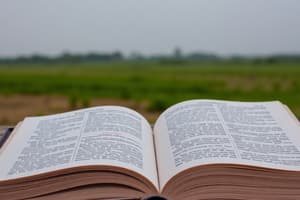Podcast
Questions and Answers
What is the script used for writing Bengali?
What is the script used for writing Bengali?
- Cyrillic
- Latin script
- Bengali script (correct)
- Arabic script
Which of the following authors is a key figure in modern Bengali literature?
Which of the following authors is a key figure in modern Bengali literature?
- William Shakespeare
- Chandidas
- Kazi Nazrul Islam (correct)
- Vidyapati
During which event was the Language Movement in East Pakistan advocated?
During which event was the Language Movement in East Pakistan advocated?
- Partition of India
- 1952 Language Movement (correct)
- Formation of Bangladesh
- Bengal Partition
What is a renowned festival celebrated by Bengali communities?
What is a renowned festival celebrated by Bengali communities?
Which cuisine is typically associated with Bengali food?
Which cuisine is typically associated with Bengali food?
What type of music is recognized as a rich tradition in Bengali culture?
What type of music is recognized as a rich tradition in Bengali culture?
What is the typical sentence structure in Bengali syntax?
What is the typical sentence structure in Bengali syntax?
Which of these regions predominantly speaks Bengali?
Which of these regions predominantly speaks Bengali?
Flashcards are hidden until you start studying
Study Notes
Overview of Bengali
- Language: Bengali (Bangla) is an Indo-Aryan language spoken by over 230 million people.
- Region: Predominantly spoken in Bangladesh and the Indian state of West Bengal, also in parts of Assam and Tripura.
Script and Writing System
- Script: Bengali script is a descendant of the Brahmi script, characterized by its rounded shapes.
- Phonetics: Contains 11 vowels and 39 consonants; notable for its use of aspirated consonants.
Literature
- Historical Background:
- Has a rich literary tradition, with origins dating back to the 8th century.
- Significant medieval period with poets like Chandidas and Vidyapati.
- Modern Literature:
- Rabindranath Tagore (Nobel Laureate) is a key figure in prose and poetry.
- Other prominent authors include Kazi Nazrul Islam and Sarat Chandra Chattopadhyay.
Culture
- Festivals:
- Pohela Boishakh (Bengali New Year).
- Durga Puja, a major Hindu festival, widely celebrated.
- Cuisine:
- Known for rice, fish, lentils, and sweets (e.g., mishti doi and roshogolla).
- Music and Dance:
- Rich traditions in folk, classical (Rabindra Sangeet), and Baul music.
Politics and History
- Bengal Partition: The division of Bengal in 1905 and 1947 led to significant social and political upheaval.
- Language Movement: The 1952 Language Movement in East Pakistan (now Bangladesh) advocated for the recognition of Bengali as an official language, marking a significant moment in Bengali nationalism.
Modern Relevance
- Global Community:
- Bengali diaspora is significant, with communities in the USA, UK, and the Middle East.
- Economics:
- West Bengal is known for its agricultural output; Bangladesh has a growing economy, notably in textiles and garments.
Additional Elements
- Dialects: Includes variations such as Standard Bengali, Dhakaiya, and others.
- Influences: Interactions with other languages and cultures, such as Hindi, Urdu, and English.
Education and Media
- Literacy Rates: Efforts are ongoing to improve literacy and education in Bengali-speaking regions.
- Media: Bengali newspapers, television channels, and films are vibrant and influential in regional culture.
Key Characteristics
- Vowel Harmony: A distinctive feature in the phonological system.
- Syntax: Subject-Object-Verb (SOV) order is typical in sentence structure.
Preservation Efforts
- Cultural Heritage: Initiatives to preserve and promote the Bengali language in education and public life.
- Bengali in Digital Space: Increasing presence of Bengali on the internet encourages modern usage and cultural expression.
Overview of Bengali
- Bengali, also known as Bangla, is spoken by over 230 million people.
- It is the primary language of Bangladesh and the Indian state of West Bengal, also spoken in Assam and Tripura.
Script and Writing System
- The Bengali script originated from the Brahmi script and has distinctive rounded shapes.
- Contains 11 vowels and 39 consonants, known for its usage of aspirated consonants.
Literature
- Bengali literature traces its roots back to the 8th century.
- The medieval period saw prominent poets like Chandidas and Vidyapati contribute significant works.
- Modern literature is greatly influenced by Rabindranath Tagore, a Nobel Laureate known for his prose and poetry.
- Other noteworthy authors include Kazi Nazrul Islam and Sarat Chandra Chattopadhyay.
Culture
- Pohela Boishakh marks the Bengali New Year, while Durga Puja is a prominent Hindu festival celebrated widely.
- Bengali cuisine is characterized by rice, fish, lentils, and sweets like mishti doi and roshogolla.
- This language boasts rich traditions in folk, classical (Rabindra Sangeet) and Baul music, along with various dance forms.
Politics and History
- The partition of Bengal in 1905 and 1947 significantly impacted social and political dynamics.
- The 1952 Language Movement in East Pakistan (now Bangladesh) advocated for Bengali as an official language, solidifying its importance in Bengali nationalism.
Modern Relevance
- The Bengali diaspora has significant presence in countries like the USA, UK, and the Middle East.
- West Bengal holds a prominent position in agriculture, while Bangladesh is experiencing economic growth particularly in textiles and garment sectors.
Additional Elements
- Bengali has various dialects, including Standard Bengali and Dhakaiya, influenced by languages like Hindi, Urdu, and English.
Education and Media
- Efforts are underway to improve education and literacy in Bengali-speaking regions.
- The region boasts a vibrant media landscape with influential newspapers, television channels, and films.
Key Characteristics
- Bengali exhibits vowel harmony as a prominent feature of its phonology.
- Its syntax adheres to a Subject-Object-Verb (SOV) order.
Preservation Efforts
- Initiatives focus on preserving and promoting the Bengali language in education and public life.
- The increasing presence of Bengali on the internet fuels modern usage and cultural expression.
Studying That Suits You
Use AI to generate personalized quizzes and flashcards to suit your learning preferences.




